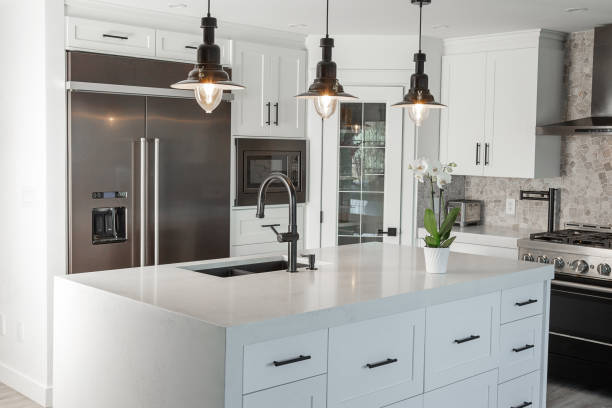
Proper installation is crucial. The question of whether dishwashers and other appliances should be installed before or after countertops in a kitchen remodel or renovation has sparked a common debate among homeowners and professionals alike.
Installing dishwashers, refrigerators, and cooktops before cabinetry and countertops allows for a seamless integration of the appliances into the overall design of your kitchen or bathroom. It ensures that the appliances in your new kitchen are properly aligned with the cabinets and other elements during the kitchen remodel or renovation, creating a cohesive look.
In the upcoming sections, we will provide helpful insights to guide you in making an informed decision regarding the installation order of your kitchen appliances and stainless steel countertops.
Are you ready to transform your kitchen into a stylish and functional space? Look no further! Kitchens by RUPP is your trusted partner in crafting dream kitchens.
Factors to Consider When Deciding on an Installation Order
Kitchen Layout and Design Plans

Considering the layout and design plans is crucial. The arrangement of your kitchen components, including appliance packages and a piece of appliance packaging, can impact the installation order. Consider incorporating stainless steel appliances for a sleek and modern look. If you have a specific vision for your kitchen design, it's important to plan accordingly.
One crucial aspect of this planning is to install countertops that complement your desired aesthetic. Additionally, consider choosing appliance packages that include a full-piece appliance package made of stainless steel. For example, if you want a large kitchen island with a built-in stainless steel range, it may be more practical to install the countertop first to ensure proper fit and alignment with the appliances.
Types of Appliances and Countertops Being Installed
The type of kitchen appliances, such as stainless steel ranges and countertops, being installed also plays a role in determining the installation order. Different kitchen appliances, including stainless steel ranges, have varying requirements for installation, such as gas lines or electrical connections.
Similarly, when installing kitchen appliances, such as appliance packages, it is important to consider the specific support structures or modifications needed. This is especially true for stainless steel appliances. Considering these factors will help determine whether it's more practical to install the stainless steel appliances before or after the kitchen countertops.
Accessibility for Future Maintenance or Repairs
Another factor to consider when choosing kitchen appliances is accessibility for future maintenance or repairs. It's important to select appliance packages that include durable stainless steel options. Having easy access to kitchen appliances is essential, as they may require occasional servicing or repairs.
By installing kitchen appliances before kitchen countertops, you can ensure that they are easily reachable if any kitchen issues arise down the line. On the other hand, if you install kitchen countertops first, it might be more challenging to access and service kitchen appliances without causing damage.
Timeframe and Budget Constraints
Timeframes and budget constraints are significant considerations when deciding on the installation order for kitchen appliances. The appliance package should be chosen carefully to ensure that it fits within both the desired timeframe and budget.
If you're working on a tight schedule or have limited resources, it might be more efficient to install an appliance package at once rather than waiting for one component to be completed before starting another. However, keep in mind that some installations, such as appliance packages, may require coordination between different professionals (e.g., plumbers and electricians), which could affect your timeline.
Pros of Installing Countertops Before Appliances
Easier Measurement and Customization Process for Countertops
Installing countertops before appliances offers several advantages. One major benefit is that it simplifies the measurement and customization process for your countertops. When the countertops are already in place, it becomes easier for the installer to take accurate measurements and make precise cuts. This ensures a better fit and minimizes the risk of errors or gaps between the countertop and appliances.
Seamless Integration with Backsplash, Sink, and Fixtures

Another advantage of installing countertops first is that it allows for seamless integration with other elements in your kitchen, such as the backsplash, sink, and fixtures. By installing the countertops beforehand, you can ensure that they align perfectly with these components. This creates a cohesive look and eliminates any potential issues or gaps when fitting them together later on.
Avoids Potential Damage to Appliances During Countertop Installation
When you install appliances before countertops, there is always a risk of damage during the countertop installation process. The heavy tools used to cut and install countertops can accidentally scratch or dent your brand-new appliances if they are already in place. By installing the countertops first, you eliminate this risk.
Provides a Clear Workspace for Installers
Installing countertops before appliances also provides installers with a clear workspace to carry out their tasks efficiently. Installers have more freedom to move around comfortably without appliances obstructing their work area while measuring, cutting, and installing the countertops. This can lead to faster installation times and potentially reduce labor costs.
Cons of Installing Countertops Before Appliances
Limited Flexibility in Appliance Choices Due to Pre-Determined Measurements
One drawback of installing countertops before appliances is the limited flexibility it offers. Since the measurements for the appliances are predetermined based on the installed countertops, you may find yourself restricted in terms of the size and style of appliances you can select. This lack of flexibility can be frustrating if you have a specific appliance in mind that doesn't fit within the predetermined dimensions.
Potential Risk of Damage to Newly Installed Countertops During Appliance Installation
Another disadvantage is the potential risk of damaging your newly installed countertops during the appliance installation process. When installing heavy appliances such as refrigerators or dishwashers, there is a chance that they could accidentally scratch or chip your countertops. This can be particularly concerning if you've invested in high-end or delicate countertop materials like granite or marble, as any damage could be costly to repair or replace.
Challenges in Aligning Appliances with Existing Electrical, Plumbing, or Gas Connections
Aligning appliances with existing electrical, plumbing, or gas connections can also pose challenges when installing countertops first. If these connections are not properly aligned with the predetermined measurements, it may require additional work and adjustments to ensure everything fits correctly. This can be time-consuming and may even require hiring professionals to make any necessary modifications.
Increased Difficulty in Making Adjustments or Modifications Later On
One final drawback is that installing countertops before appliances can make it more difficult to make adjustments or modifications in the future. If you decide to upgrade your appliances down the line or need to replace a faulty one, you might face difficulties finding an exact fit due to the pre-determined measurements set by your installed countertops. This lack of flexibility could potentially result in additional costs for modifying your countertops or settling for an appliance that isn't your preferred choice.
Addressing Potential Issues During Countertop Installation
During the installation of countertops, several potential issues may arise. It is essential to address these concerns to ensure a smooth and successful installation process. Let's take a closer look at some tips and strategies that can help mitigate any issues that may occur.
Protecting Countertops from Scratches or Chips During Appliance Installation
One common concern when installing appliances after countertops is the risk of scratches or chips. To protect your countertops during appliance installation, consider the following tips:
- Place protective coverings over the countertop surface before moving appliances into place.
- Use caution when positioning heavy appliances to avoid dragging them across the countertop.
- Make sure all appliances are properly aligned and leveled to prevent any unnecessary movement that could damage the countertop material.
By taking these precautions, you can minimize the risk of damage to your countertops during appliance installation.
Ensuring Accurate Measurements Prior to Ordering Countertops
Accurate measurements are crucial when ordering countertops, especially if appliances will be installed afterward. Here are some methods to ensure precise measurements:
- Measure twice: Double-check all measurements before placing an order for countertops.
- Consider future appliance dimensions: Take into account the size and dimensions of appliances that will be installed later on.
- Consult with professionals: Seek advice from experienced contractors or kitchen designers who can guide you in obtaining accurate measurements.
By following these steps, you can avoid measurement errors and ensure a proper fit for both your countertops and appliances.
Coordinating with Multiple Contractors Involved in the Process
In many cases, coordinating with multiple contractors is necessary when installing both countertops and appliances separately. To streamline this process:
- Communicate effectively: Maintain open lines of communication between all parties involved, including countertop installers, appliance installers, contractors, and yourself.
- Create a timeline. Establish a clear timeline for each phase of the installation process to ensure that all contractors are aware of their respective responsibilities and deadlines.
- Consider a project manager: If coordinating multiple contractors becomes overwhelming, hiring a project manager can help oversee the entire process and ensure smooth coordination.
By effectively coordinating with all parties involved, you can minimize confusion and ensure that each contractor understands their role in the installation process.
Minimizing Disruption During the Installation Phase
Installing countertops before appliances may cause some disruption in your kitchen. However, there are strategies you can employ to minimize this inconvenience:
- Create a temporary workspace: Set up a temporary area in another part of your home where you can prepare meals while the appliances are being installed.
- Plan ahead: Coordinate with your contractors to schedule appliance installation at a time when it will have minimal impact on your daily routine.
- Communicate expectations: Clearly communicate any specific requirements or preferences regarding the installation process to your contractors.
By implementing these strategies, you can reduce disruptions and make the installation phase as smooth as possible.
Recommendations for Countertop Installation in Relation to Appliances

One common question that arises is whether appliances should be installed before the countertops. Let's explore some recommendations based on the size and complexity of the kitchen, as well as suggestions for involving all stakeholders early on.
Best Practices Based on Kitchen Size and Complexity
The size and complexity of your kitchen can play a significant role in determining whether appliances should be installed before or after the countertops. Here are some best practices to consider:
- Small and simple kitchens: If you have a small and straightforward kitchen with minimal appliances, it may be more practical to install the countertops first. This allows for easier maneuverability during installation and ensures that the countertops fit perfectly without any adjustments being needed.
- Large and complex kitchens: On the other hand, if you have a larger kitchen with multiple appliances, such as a dishwasher or a French door refrigerator, it might be more efficient to install these appliances before the countertops. This way, any necessary electrical or plumbing connections can be made without interfering with the finished countertops.
Suggestions for Involving All Stakeholders Early On
To ensure a smooth countertop installation process, it's crucial to involve all stakeholders—homeowners, designers, and contractors—from the beginning stages of planning. Here are some suggestions:
- Homeowners: As a homeowner, communicate your preferences and priorities regarding appliance placement early on in the design process. This will help designers and contractors decide when to install appliances relative to countertops.
- Designers: Designers should work closely with homeowners to understand their vision for both appliance placement and countertop design. By collaborating effectively, they can create a cohesive plan that accommodates both functional needs and aesthetic preferences.
- Contractors: Contractors are essential in executing the installation process according to homeowners' requirements. They should coordinate with designers and homeowners to ensure appliances and countertops are installed in the most efficient and practical order.
Factors that May Influence the Decision-making Process
Several factors can influence the decision of whether to install appliances before or after countertops. Consider these factors when making your choice:
- Seamless integration: If you desire seamless integration between your appliances and countertops, installing the appliances first allows for a more precise fit and alignment.
- Electrical and plumbing connections: Installing appliances before countertops can simplify the process of connecting electrical wiring or plumbing lines, especially if modifications or adjustments are needed.
- Time constraints: In some cases, time constraints may dictate the installation order. For example, if there is limited availability for appliance delivery, it may be more practical to install the countertops first.
Potential Compromises or Alternatives if Conflicting Priorities Arise
In situations where conflicting priorities arise between appliance installation and countertop placement, compromises or alternatives can be explored. Here are a few options:
- Temporary countertop solutions: Consider using temporary countertop materials like plywood or MDF until all appliances are installed. This allows for functional use of the kitchen while ensuring that the final countertops are installed correctly.
- Flexible installation schedules: Coordinate with contractors to develop a flexible installation schedule that accommodates both appliance installation and countertop placement without compromising on quality or efficiency.
- Collaborative problem-solving: Engage in open communication with all stakeholders to find creative solutions that address conflicting priorities while still meeting functional requirements.
Tips for a Successful Countertop Installation Process
Proper Planning and Communication
Proper planning and effective communication ensure a smooth countertop installation process. It is crucial to establish clear lines of communication between all parties involved, including the homeowner, contractor, and countertop installer. This ensures that everyone is on the same page and understands their respective roles and responsibilities.
Proper planning involves discussing the timeline, scheduling, and any specific requirements or preferences with all parties. For example, if you're located in Oregon City, Oregon, it's important to communicate your location to the countertop installer so they can plan accordingly. Discussing any potential challenges or obstacles beforehand allows for proactive problem-solving.
Accurate Measurements Using Digital Tools or Templates
Accurate measurements are essential for a successful countertop installation. Gone are the days of relying solely on manual measurements; digital tools and templates have revolutionized this process. By utilizing advanced technology such as laser measuring devices or digital templating systems, precise measurements can be taken with ease.
These digital tools provide accurate dimensions of the space where the countertops will be installed. This eliminates guesswork and reduces the risk of errors during fabrication. With precise measurements in hand, the countertop fabricator can create countertops that fit perfectly into your space.
Quality Control Checks Throughout the Fabrication Process
Maintaining quality control throughout the fabrication process is crucial to ensuring that your countertops meet your expectations. This includes regular inspections at various stages of fabrication to identify any potential issues early on.
During fabrication, it's important to check for flaws such as cracks, chips, or uneven surfaces. By catching these issues early on, necessary adjustments can be made before installation begins. Regular quality control checks also help ensure that your countertops are fabricated according to the agreed-upon specifications.
Regular Updates on Progress to Avoid Delays

Communication doesn't end once planning is complete; regular updates on progress are essential to avoid any delays in the installation process. By staying informed about the status of your countertops, you can plan accordingly and make any necessary adjustments to your schedule.
Regular updates also allow you to address any concerns or questions that may arise during the fabrication process. This ensures that everyone involved is aware of any potential challenges and can work together to find solutions.
The Best Approach for Installing Countertops and Appliances
Evaluating Individual Project Requirements and Constraints
There is no one-size-fits-all approach. Each project has its own unique requirements and constraints that need to be evaluated carefully. Factors such as the size of the kitchen, the layout, the type of countertops chosen, and the specific needs of the homeowner all play a role in determining the best installation order.
Considering the Specific Needs and Preferences of the Homeowner
One crucial aspect to consider when deciding whether to install appliances before or after countertops is the specific needs and preferences of the homeowner. Some homeowners may prioritize having their new appliances up and running as soon as possible, while others may prioritize installing their countertops first for aesthetic reasons.
Here are some pros and cons to consider:
Pros:
- Installing appliances first allows homeowners to use them immediately without waiting for countertop installation.
- It provides an opportunity to test out new appliances before finalizing countertop measurements.
- It allows for easier access to electrical outlets and plumbing connections during appliance installation.
Cons:
- If appliances are installed before countertops, there is a risk of damaging them during countertop installation.
- Countertop fabricators may have difficulty accurately measuring for cutouts if appliances are not present during template creation.
- It can be challenging to align appliances properly with cabinets if countertops are already in place.
Collaboration Between Countertop Fabricators and Appliance Installers
To ensure a smooth installation process, collaboration between countertop fabricators and appliance installers is essential. Communication between these two parties can help determine which approach will work best for each specific project. By working together closely, they can address any potential issues or concerns early on in the process.
For example, countertop fabricators can provide precise measurements based on appliance specifications shared by appliance installers. This collaboration ensures that cutouts for cooktops, sinks, and other appliances are accurate and properly aligned.
Flexibility to Adapt Installation Order Based on Unique Circumstances
In some cases, it may be necessary to adapt the installation order based on unique circumstances. For instance, if a homeowner has chosen a specific type of countertop material that requires special handling or additional time for fabrication, it might make sense to install the appliances first.
Ultimately, the decision of whether to install countertops before or after appliances should be made on a case-by-case basis. It is crucial to consider factors such as project requirements, homeowner preferences, collaboration between countertop fabricators and appliance installers, and any unique circumstances that may impact the installation process.
By evaluating these factors carefully and working closely with professionals in both countertop fabrication and appliance installation, homeowners can ensure a successful kitchen remodel or renovation that meets their needs and preferences.
Should Appliances Be Installed Before Countertops?
Whether to install appliances before countertops or vice versa ultimately depends on your specific circumstances and preferences. Consider factors such as the type of appliances you have, the complexity of countertop installation, and any potential issues that may arise during the process.
While installing countertops before appliances offers advantages like ease of installation and flexibility in design choices, it also poses challenges such as potential damage to countertops during appliance installation. On the other hand, installing appliances before countertops can ensure a seamless fit and minimize any risks associated with countertop installation.
Consult professionals and weigh the pros and cons based on your unique situation. Doing so lets you make an informed decision that best suits your needs and ensures a successful outcome for your appliances and countertops.
Elevate your kitchen to new heights of style and functionality with Kitchens by RUPP. Our experienced designers and craftsmen are here to bring your culinary dreams to life. Contact us now to schedule a consultation. Let's make your dream kitchen a reality.

Ready to Design Your Kitchen?